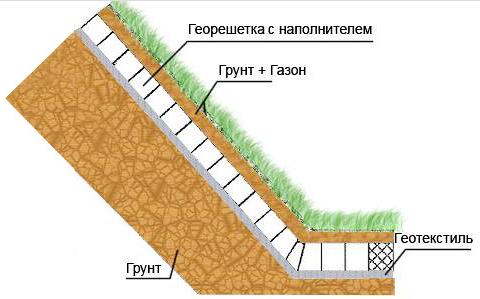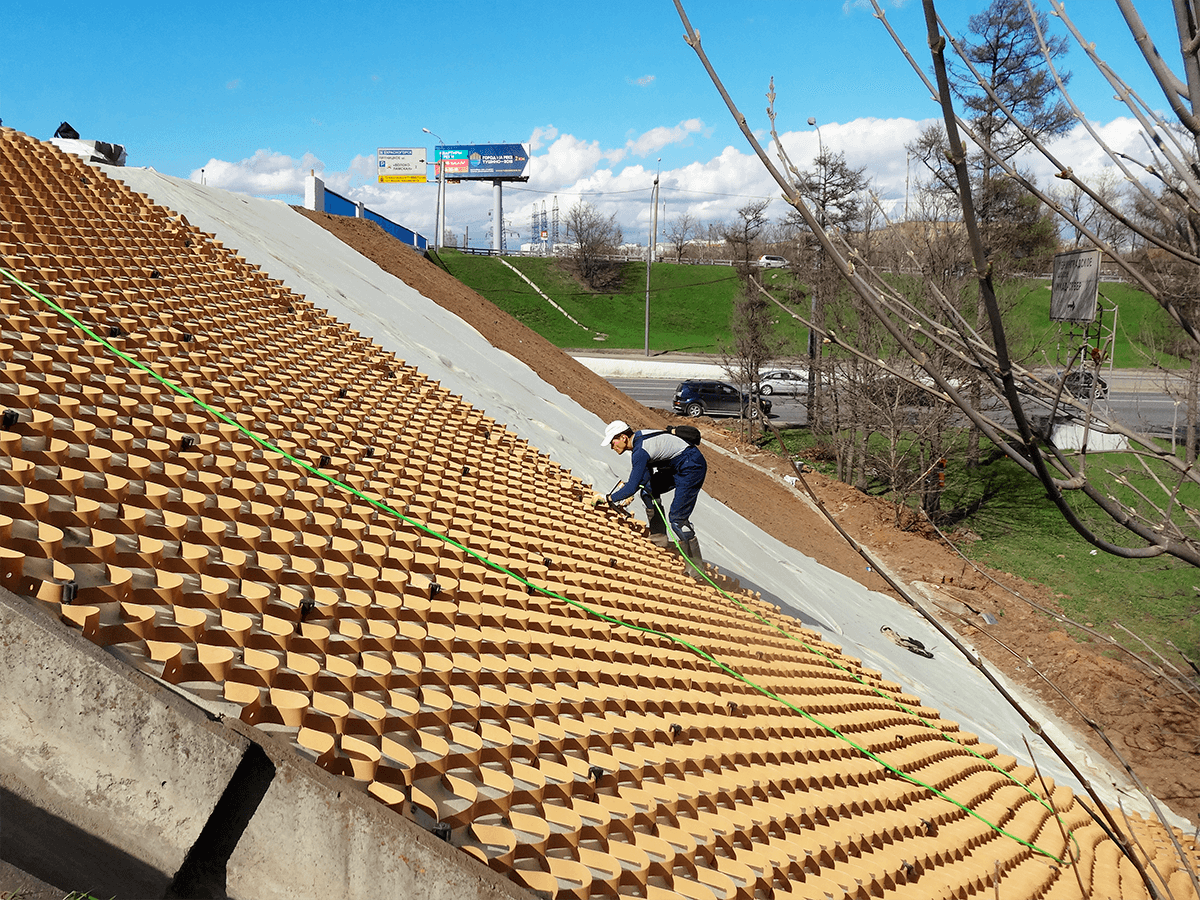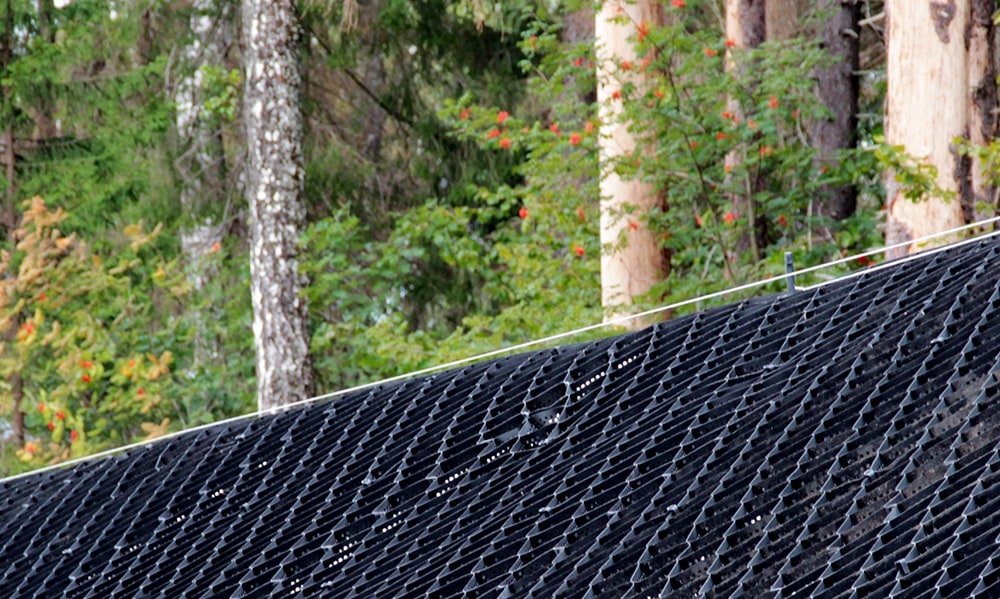What Is Geotextile and What Is It For?
The word «geotextile» is well known in the world of geosynthetics and civil engineering and is quite often used in everyday life.
In this article, we will look into what kind of material it actually is, how, where, and most importantly why it is used.

WHAT IS GEOTEXTILE AND WHAT IS IT FOR?
Geotextile is a type of geosynthetics, woven (geo-fabric) or non-woven fabric made by needle-punched, heat-bonded or hydro-bonded method from polypropylene and/or polyester yarns. Thus, the material can be classified depending on the raw material and the manufacturing method.
The prefix «geo» clearly indicates that this material is used primarily in earthwork (like other geosynthetic materials). So, geotextiles are used to create reinforcing, dividing, draining, filtering and/or protective layers in various building structures.
Many construction companies choose needle-punched geotextiles, because due to the high filtering capacity it is suitable for any soil, including clay. The design using geotextiles and reinforcing geogrid has maximum strength and versatility.The main function of geotextiles is to protect the foundation from various kinds of soil deformation (excess water, root sprouting, displacement and mixing of layers).
We can also distinguish the following main functions of geotextile:
- LAYERING
Laying a non-woven synthetic material between the structural layers of the pavement helps to prevent the mixing of the layers, which increases the bearing capacity of the base, the internal stiffness of the layers, reduces the deformation of the embankment, decreases the size of the subsidence, and also increases the overall resistance of the structure to loads.
- PROTECTION
Due to its high resistance to mechanical damage, non-woven geotextile can be used for external protection of waterproofing membranes, for example, in the construction of water tanks or solid waste landfills, or to protect the insulation of pipelines. The needle-punched fabric is placed under the waterproofing material and prevents direct contact of the geomembrane with the source of mechanical damage, thereby eliminating the risk of rupture of the waterproofing layer.
- FILTRATION
Due to the porous structure, the non-woven geosynthetic material lets the water pass both in the longitudinal and in the transverse direction, preventing the layer of crushed stone from silting up, and at the same time retains small particles of soil and sand. Thus, geotextiles are often used in various filtration systems.
- DRAINAGE
Geotextiles have a high capillarity, that is, the ability to quickly let the water pass in the longitudinal and transverse directions. This property allows the use of geotextile fabric in structures to ensure the removal of excess moisture (drainage), for example, when reinforcing slopes with three-dimensional geocells.

• Increase in the bearing capacity of the bases
• Improvement of drainage properties, acceleration of water drainage
• Reduced embankment deformation
• Reduced embankment subsidence
• Acceleration of soil consolidation
• Prevention of soil erosion
• Reduced material consumption during construction
• Extension of the service life of buildings
ADVANTAGES OF GEOTEXTILES
Obviously, the high demand for geotextiles in civil engineering and other areas is due to its unique characteristics and a number of advantages. Let’s look into each of them:
- VERSATILITY
Due to its resistance to mechanical damage, changes in temperature, exposure to aggressive environments and microorganisms, as well as elasticity and water permeability, geotextiles can be used for a variety of construction sites and designs.
- STRENGTH
ГGeotextile is resistant to stretching, and therefore can be used for strengthening various structures, including high-load roads, building foundations, etc.
- LONGEVITY
Geotextile is resistant to acids, alkalis, and microorganisms and is suitable for use in any climatic conditions. The only parameter of wear is a gradual decrease in the filtering capacity due to the filling of pores with fine particles of soil. However, high-quality material will serve for at least 30 years.
- COST-EFFECTIVENESS
Geotextile is produced from relatively inexpensive raw materials and using simple technology. In addition, the use of geotextiles can reduce the consumption of building materials, and hence the cost of installation.
- SIMPLICITY OF INSTALLATION
Laying of geotextile does not require special skills or training. The material is delivered in rolls convenient for transportation, and is easy to cut with ordinary scissors.
- ECO-FRIENDLINESS
Geotextiles do not emit harmful substances during operation. Production is also environmentally friendly, and the use of recycled materials meets modern environmental standards.

Slope reinforcement with the use of weld-free geocell GEOSTEP® and geotextile GEOKNIT-N
WHERE IS GEOTEXTILE APPLIED?
Geotextile has proven its effectiveness in a great number of areas: from laying tracks on a private housing estate to constructing dams and laying pipelines.
Due to its unique properties, geotextiles are also used in medicine, agriculture, furniture industry, for the manufacturing of packaging and in other fields.
Needle-punched non-woven geotextile fabric is intended for repair, construction, reconstruction of roads, installation, and repair work on gas and oil pipelines, for the construction of railways, landscape work, and other general business needs.
HOW TO CHOOSE GEOTEXTILES?
The choice of geotextiles depends on where the material will be applied and the function that it has to perform. The main indicators are density, strength and filtration coefficient. Depending on the application, these indicators will vary.
Our experts will prepare a calculation and select the appropriate material, taking into account the individual characteristics of your project. Contact us by phone +7 (499) 673-37-33 (ext. 502) or send a request to sales@presto.ru.

 About Us
About Us 






